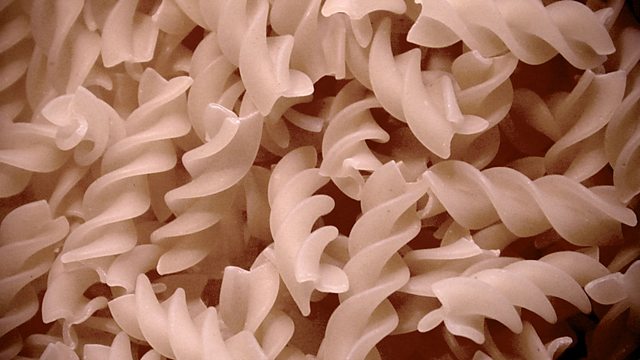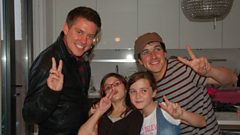
11/01/2013
The final chapter of this week's story The Silver Bead, plus Cornish pasta (no, not pasties), and more 'How Dangerous Is Your House' experiments with Dick and Dom.
Last on
Clip
-
![]()
Dick and Dom: Bedroom
Duration: 12:17
Activity 1: Observing your eyes
Have you noticed when the lights are turned out at night, after a few minutes your eyes adjust to the dark? This activity lets you see one of the changes that happens to your eyes as light levels change.
��
Light gets into your eyes through your pupils, which are the little black dots at the front of your eye. The pupil is actually a hole, and light travels through it to a very sensitive area at the back of your eye called the retina. Your pupils can change size to let more or less light in. So on a bright sunny day, your pupils will shrink and get smaller. In the dark, they get bigger, to let more light in.
��
You can see this happening yourself if you have a mirror, and a torch. Turn out the lights and give your eyes a few minutes to adjust to the dark. Then, standing in front of the mirror so that you can see your eyes, turn on the torch. Don't shine it directly into your eyes! Look at what happens to your pupils as the light comes on: can you see them shrink?
��
Another way to do this without turning lights out is to sit in front of a mirror, and cover one eye with your hand for a few minutes. When you remove your hand from your eye, watch your pupil get smaller.
Activity 2: 91�ȱ�made planetarium
Bring a little bit of the night sky inside by making your own star projector.
��
You will need:
- A cardboard tube (eg from a tube of biscuits, or the inside of a kitchen roll)
- a torch that will fit inside your tube (with a single bulb)
- a pin
- a star map
��
Take your cardboard tube. It needs to have one end open, and the other covered. The covered end needs to be thin enough to push a pin through to make a hole. So, if your tube already has an end that you can push a pin through, you can skip the first step. If your tube has no end, or an end that is too solid to make holes in, you need to make a new cover for it. You can do this simply by cutting a circle of card or dark paper, and tape it on to the end like a lid.
��
Take your star map, and choose a constellation that will fit onto the covered end of your tube. You can either draw it on as dots, or if you have your star map on a piece of paper, simply place it over the end of your tube. Take your pin, and prick holes in the covered end of your tube, in the pattern of the constellation you have chosen.
��
Get your torch, and turn off all the lights. Put your torch inside the tube, and point it at the ceiling. You should see your constellation projected as points of light. If you move your tube closer to the ceiling, the points of light will get smaller and sharper - take it further away and they get bigger and blurrier. You need to use a torch with a single bulb for this activity. If you use a modern touch with multiple LEDs inside, you'll get multiple points of light for each star in your constellation.
Activity 3: Coat hanger church bells
This activity shows your there's more to a metal coathanger than meets the eye – or ear!
��
You will need:
- ��2 metal coat hangers, the heavier the better
- string
Cut two lengths of string about a metre long, and tie a piece to each coat hanger. Knock the coat hangers together. How does it sound? Now, wind the other end of each piece of string around your index fingers, and stick them in your ears. Learn forward slightly so the coat hangers are hanging freely, dangling from your ears/fingers. Now clang them together again. Has the sound changed? What's happening?
��
The coat hangers will make a bonging noise, a bit like a church bell – very different from how it sounds when you don't have the string by your ear. Sound is made of vibrations, which travel better through a solid, such as the string, than they do through the air. So what you are hearing is the sound travelling straight up the string, without being diffused by the air around you.
Broadcasts
- Fri 11 Jan 2013 16:0091�ȱ� Radio 4 Extra
- Fri 22 Mar 2013 16:0091�ȱ� Radio 4 Extra

